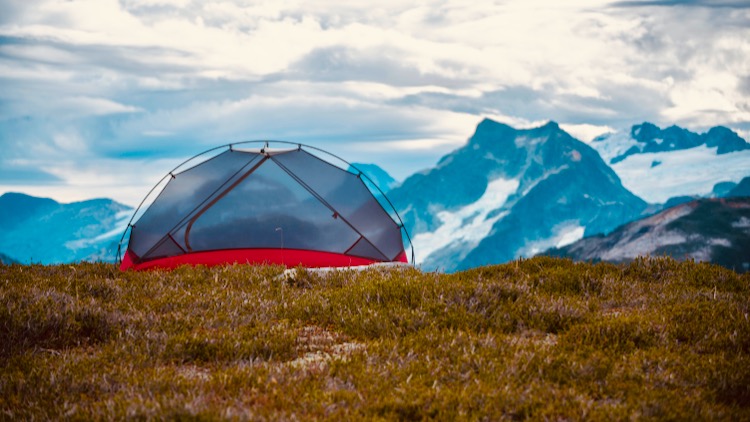Life under the stars is better with the best inflatable tent for camping. Can you really trust an inflatable tent out in the woods? Absolutely! I’ll show you why so many people are ditching traditional poles in favor of airy, breezy support.
In this article, we’re going to review the following inflatable tent models:
- Portal Outdoor Tents Inflatable Air
- HEIMPLANET Original – The Cave 2-3 Person Dome Tent
- Crua Outdoors Core Premium Quality 6 Person All Weather Large Family Camping Tent
- HEIMPLANET Original: Backdoor – 3 Season, 4 Person Dome Tent
- HEIMPLANET Original: Fistral Inflatable Pop Up 2 Person Tent
- Foammaker Inflatable Bubble Igloo Tent Transparent 360° Dome
- HEIMPLANET Original Fistral Inflatable Pop Up Waterproof Outdoor Camping Tent
A Buyer’s Guide to Inflatable Tents for Camping
Why is hot air the hottest thing in the world of tents right now? Anyone who has dealt with the difficulties of traditional poles will understand why it was due time for a great alternative to land on the market. Inflatable tents use “air poles” for support.
While using air to keep your tent upright while camping may seem iffy, the truth is that the technology behind inflatable tents is more than amazing. In fact, air poles are just as durable as traditional poles.
Why Would You Use an Inflatable Tent?
The big draw with inflatable tents is that they’re much easier to erect than traditional pole tents. In fact, this is why they have been gaining steam among people who like to trek alone. Unlike traditional tents, you can reasonably expect to erect an air tent on your own without help once you get in a few practice sessions.
Air tents use air tubes to prop up your tent instead of plastic or metal rods. Your tubes are built right into the tent material to prevent the need for you to “assemble” anything. You’re getting your structure from the inflated tubes without the need to add extra weight. The “weight” of the poles is added when air is added.
You can already see what a big difference an inflatable tent will make with carrying a load when compared to a tent that requires you to lug a heavy frame along to your campsite. Here’s a look at some of the other advantages:
1. One person can get an inflatable tent up in minutes without asking for an extra hand!
2. There’s no need to worry about a pole snapping or breaking!
3. Inflatable tents come in modern, sleek designs with a serious “cool factor.”
Most people who make the switch to an inflatable tent vow to never go back to the restrictions of traditional tents. However, it’s important to ensure that you understand the potential drawbacks to ditching your poles before you get out in the wilderness with an inflatable tent.
First, you’ll need to bring along an air pump when you camp. This isn’t a huge pain point because many campers already do this because they use inflatable mattresses for sleeping. Many tent manufacturers actually throw in a nice air pump when you buy a tent.
There’s also the fact that inflatable tents actually tend to be slightly heavy to carry. Yes, that may seem counterintuitive due to the fact that you’re not lugging poles around. However, the extra bulkiness all comes down to design.
Traditional pole tents are often assembled in pieces. That means you can distribute the weight around as you trek. By contrast, inflatable tents are often designed as a single large piece.
How to Choose a Good Inflatable Tent
Like all types of tents, you’re never looking at “one thing” when you shop around for inflatable camping tents. Inflatable tents come in many different styles that offer different pros and cons based on your camping needs.
Frame Design
Most inflatable camping tents that you’ll find for sale use something called an interlink frame. This design is really practical for most campers because it allows you to pitch your tent in actual seconds. You’ll just “pump” one area to watch your entire tent rise up!
Some frames on inflatable tents provide you with the option to clip your tent frame into different portions. The benefit here is that an air leak in one area won’t impact the rest of the structure because it will be contained within the clipped area.
You’ll have no trouble finding interlinked inflatable camping tents in different sizes that can fit single campers, couples, families, or hikers.
Materials
Use all of the same rules and best practices for materials when shopping for an inflatable tent that you would when shopping for any kind of tent. While the structural setup is different between inflatable and pole tents, your needs for insulation, protection, and comfort are all the same. Polyester, PVC, and nylon ripstop are still the preferred materials for proper insulation and breathability.
Features and Compartments
Inflatable tents offer all of the same options for features and compartments as traditional tents. Consider your need for “separate rooms” in your tent if you like having a private bedroom. If you tend to camp in wetter areas, a vestibule where you can keep shoes, jackets, gloves, and hats is always nice.
It’s also a bonus when a tent provides a groundsheet. Groundsheets make your sleeping experience more comfortable by providing a barrier against cold, moisture, and insects.
What About Reliability?
Do you need to worry about waking up in a deflated tent if you go with an inflatable tent? While these tents technically get their structure from air, you’re still getting a very sophisticated design that is designed to provide sturdiness through a balanced blend of elasticity and resistance.
An inflatable tent that’s tethered has an incredible ability to flex with the wind that actually beats standard tents. You also don’t have to worry about snapped poles when heavy winds roll in. The rigidity of standard tents can actually make them more volatile in windy conditions compared to inflatable tents. While a puncture is always possible with an inflatable tent, it’s far easier to patch up a puncture hole than it is to try to prop up a tent with a snapped pole.
In addition, inflatable tents tend to be waterproof by default.
User error does pose some potential risk for inflatable tents. The most common reason for tent failure with inflatable tents is excessively inflating your pillars. The risk here is that your pillars could actually pop under pressure. Fortunately, taking time to read instructions carefully once you get your tent unboxed should be enough to prevent this from happening.
What Do I Need to Know Before Using an Inflatable Tent?
Don’t set yourself up for any surprises. Make sure you do a “practice run” at home with your tent before you bring it out on a camping trip. Truthfully, you should be doing this with any kind of tent.
First, take the tent out of its packaging. You never want to trust that your newly purchased tent is in perfect shape before bringing it on its first camping trip. Take it out of its packaging to inspect every inch.
Next, set up the tent. This step has two purposes. The first is to ensure that you know how to set up the tent once you arrive at your campsite. The second is to check for any defects that will render your tent unusable at your campsite.
Don’t just quickly set up your tent before deflating it! You actually want to keep the tent set up for a few hours to confirm that it doesn’t have any holes that will cause it to deflate slowly.
FAQ
How Do Inflatable Tents Stay in Place?
Inflatable tents are able to stay up without poles because they have built-in air tubes that give them their structure.
Do You Need an Air Pump for an Inflatable Tent?
Yes! However, a basic foot pump is often enough to quickly pump up your tent. Most tent brands actually include air pumps when you buy a new tent.
How Many People Can Sleep in an Inflatable Tent?
Inflatable tents come in all sizes and styles. It’s common to find inflatable tents with room for one person to six people!
Are Inflatable Tents Safe in Bear Areas?
All tents are vulnerable to bears. A bear can very easily crush a tent pole on a traditional tent. However, air-filled support tubes can be more vulnerable to bear swipes than other types of tents. Always bring a patch kit along when camping with an inflatable tent.
Reviews of the Best Inflatable Camping Tents
1. Best for Easy Camping With the Family: Portal Outdoor Tents Inflatable Air

Dimensions: 185.04 x 118.11 x 74.8
Weighing 10.47 kg, this five-person waterproof tent is evergreen for all seasons. While the body of the tent is made from 100% durable polyethylene, the inner tent and flysheet are made of polyester. You’ll find that this portal is a great fit for a family because of its cozy layout that offers just enough roominess and privacy without the need to upgrade to an enormous tent.
This attractive, ultra-comfortable portal goes up easily using traditional inflatable beams. The tent’s layout is divided between a living area, large porch, and bedroom. The living area in this tent is roomy enough for a small table with chairs. A sewn-in groundsheet provides comfort, insect protection, and a barrier against moisture.
The large windows help you feel connected to your beautiful surroundings while camping. Overall, “easiness” is really the theme of this very sturdy tent.
Pros:
- Nice layout for a family.
- Waterproof.
- Groundsheet provides a nice barrier from the elements.
- Comes with a carrying case.
- Comes with an air pump.
- Easy to erect.
- Easy to take down.
- You can stand up in this tent.
Cons:
- Some people claim that this tent struggles a little in the rain.
- The larger size comes with extra weight.
2. Best for Windy Conditions: HEIMPLANET Original – The Cave 2-3 Person Dome Tent
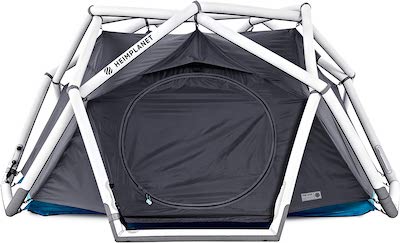
Dimensions: 15.75 x 12.99 x 9.45
This three-season tent is deliciously compact. While it is technically designed for two to three guests, the truth is that this tent is really ideal for no more than a couple. You could justifiably use this as a single-person tent if you want to splurge on roominess for yourself.
At 4.8 kg, this tent is relatively light. I want to focus on the neat way this tent inflates. You set it up by connecting the inner tent and outer tent as part of a singular airframe. Next, the tent rolls out flat like a sleeping bag before you pump it up. It’s fun to watch it pump up in a flash after your pump is connected.
All of the air chambers in this tent are connected as a single system. However, the smart design actually allows you to separate the air chambers with some small clips to protect all of the chambers against damage that might compromise one chamber.
I’m a big fan of the pegs that come with this tent to help keep it in place against strong winds. Of course, the geodesic frame offers naturally aerodynamic wind protection. Even the roof design has stability in mind. You’ll notice a star-shaped roof that offers a perfect slope for ensuring that rain runs off nicely without pooling to add weight to the top of the structure.
All of the details I covered so far are what make this my top pick for windy camping. While the system on this tent is impressive, you’re still able to take it all down in a blink by simply opening one valve to get the entire frame deflated.
Something that lovers of the outdoors can love about this tent is that it’s made from recyclable materials. While the outer layer is constructed from extra-stiff, ultra-resistant polyester, the interior layer is made from soft and flexible thermoplastic polyurethane that provides great insulation. The actual inner-tent area is made from 100% nylon ripstop. If you’ve camped often, you know how breathable this material can feel.
There’s also a polyester flysheet. Lastly, this tent has a protective groundsheet that’s made from nylon taffeta that’s great for keeping out moisture, coldness, and bugs.
Finally, I’ll point out how practical the layout of this tent is when you’re camping. There’s a small vestibule that’s great for storing shoes, hats, and gloves. There’s also a hidden gear loft under the roof of the inner tent that adds storage. You’ll probably find that this is where you want to keep your lamp.
Pros:
- The design stands up against wind and rain.
- Great use of fabrics and materials to create a tent that’s both insulated and breathable.
- Smart frame system protects you against one chamber deflating.
- So easy to set up!
Cons:
- Better suited for one to two campers instead of three.
- No pump included.
3. Best for Camping With a Group: Crua Outdoors Core Premium Quality 6 Person All Weather Large Family Camping Tent
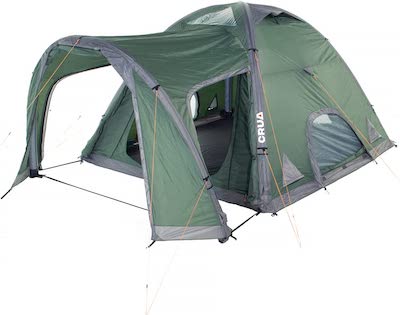
Dimensions: 21.4 x 8.6 x 7.5
This six-person waterproof tent makes an incredible “basecamp” when you’re camping as part of a hunting, fishing, hiking, or festival experience! Its larger size makes it a great choice if you’re looking for a touch of glamping because you can fit so many tagalong amenities in your living space.
This 15-kg design is made with a breathable polyester material that is swathed in a water-resistant top layer. The tent’s air-beam technology makes setup a breeze. You’re able to set up a home base for your friends or family in minutes.
There’s actually some hidden luxury to this tent. Its patented insulation blocks out bright light to allow you to sleep in on “glamping” trips. In addition, the design actually helps to reduce noise from the outside. Lastly, you’ll find that the insulation on this tent also helps to regulate the temperature to help avoid those “highs” and “lows” that often get to campers throughout the nighttime and early morning hours.
The roomy vestibule with plenty of room for everyone’s shoes is an appreciated touch!
Pros:
- Interior temperature stays very consistent.
- Plenty of room to stand up inside.
- Insulates against noise and light.
- Easy to set up.
- Includes a pump.
Cons:
- No liner.
- The larger size comes with a heftier weight.
4. HEIMPLANET Original: Backdoor – 3 Season, 4 Person Dome Tent
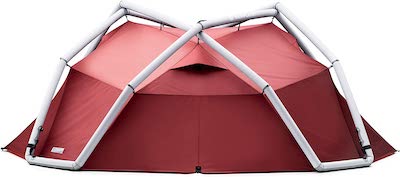
Dimensions: 20.08 x 8.27 x 10.24
This four-person tent is designed to provide three-season comfort using an easy setup that works with a cohesive airframe. The tent’s design allows it to be rolled out like a sleeping bag before you pump it up. It also comes with some nice pegs for added durability in windy conditions.
All of the chambers in this tent’s airframe are connected to allow you to pitch it using a single valve. You can disconnect the chambers using small clips after the tent is inflated to keep it stable in the event that one of the chambers is damaged.
The geodesic structure of this tent’s frame adds to its durability. In fact, the manufacturer claims that the tent can stand up to wind speeds topping 100 miles per hour.
Campers who often feel stuffy inside tents will find that this tent is a real superstar
when it comes to providing consistent airflow. The design features large mesh panels that are balanced by an interior tent made of anti-wind ripstop nylon fabric. You’re also getting floor sheets for added ground protection and insulation.
The tent is made of recyclable materials. The extra-stiff, highly resistant polyester exterior makes this tend rugged. There’s also an inner layer made of thermoplastic polyurethane, fly sheet made of ripstop polyester, and inner tent made of ripstop nylon.
At 6 kg, this is a very lightweight tent.
Pros:
- Includes air pump and repair kit.
- Materials are balanced for insulation and breathability.
- Multi-chamber system adds structural integrity.
- Geodesic structure adds durability.
- Great ventilation.
- Great wind performance.
- Lightweight.
Cons:
- Lacks storage.
5. HEIMPLANET Original – Fistral Inflatable Pop Up 2 Person Tent
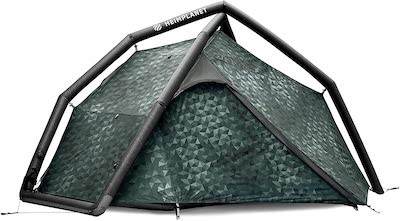
Dimensions: 8 x 14 x 8
Ideal for single campers and pairs, this inflatable tent uses a single airframe that connects the inner tent and outer tent for quick setup. It rolls like a sleeping bag to be inflated. You’re also getting some pegs to hold the tent in place against stronger winds.
Yes, there’s even that great safety feature included with other HEIMPLANET tents that allows you to clip off each portion of the frame to make separate air chambers as a way to keep the tent stable if one chamber is compromised.
Weighing just 2.5 kg, this tent is a hiker’s dream. While this tent is lightweight, its geodesic frame structure ensures stability. It’s even intended to withstand wind speeds of up to 100 miles per hour without trouble.
The resistant exterior polyester combined with an inner layer of thermoplastic polyurethane creates a nice amount of insulation. The inner tent is made of 100% nylon ripstop for breathability. You’re also getting the extra protection and insulation of a 100% nylon taffeta groundsheet.
Pros:
- Extremely light and compact.
- Roomy when used as a one-person tent.
- Stands up to wind nicely.
- Geodesic frame creates natural stability.
- Easy to inflate.
Cons:
- Pricey for such a small tent.
- Pump not included.
6. Foammaker Inflatable Bubble Igloo Tent Transparent 360° Dome
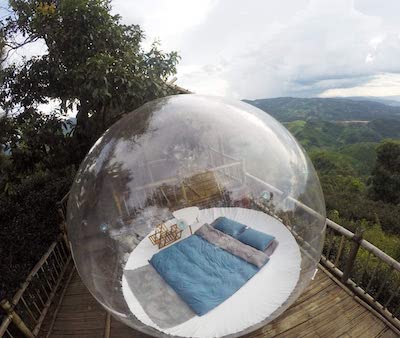
Dimensions: 13-foot diameter
This inflatable bubble tent isn’t just a novelty pick! This is a free-standing polyvinyl chloride (PVC) bubble that is designed for all four seasons. Its windproof design ensures that you can stay cozy with gorgeous 360-degree views all around you.
How on earth does this magical bubble work? The bubble stays up using a stabilizer air column. I do need to point out that this bubble tent is more “high maintenance” than other inflatable tents. You’ll actually need to keep the blower connected at all times in order to keep the bubble inflated.
While the transparent PVC used for this bubble means views galore, that PVC also allows you to stay safe from wind, moisture, insects, and more. The bubble is also fitted with ventilation air outlets. This ultra-lightweight design is extremely easy to fold and carry.
Pros:
Great views!
Lightweight PVC.
Decent protection against wind and moisture.
Cons:
- Zero privacy.
- The blower needs to be running to keep the tent inflated.
7. HEIMPLANET Original Fistral Inflatable Pop Up Waterproof Outdoor Camping Tent

Dimensions: 8 x 14 x 8
Here comes another pick from HEIMPLANET! It’s hard to deny that this brand really dominates in the sphere of inflatable tents. The size of this three-season tent makes it a great one-person tent with the potential to comfortably fit a couple. At just 2.5 kg, this tent is so easy to sling over your shoulder when trekking. Its polyester-nylon design made from recyclable materials creates that sweet spot for both breathability and durability. This is the ultimate pick for mobility!
Like the other HEIMPLANET tent reviews so far, this one features that awesome frame with connected air chambers that allow you to use clips to “zone off” the overall frame against damage in one section. You’re also getting that signature geodesic frame that helps the tent stand up to wind speeds of 100 miles per hour. The pegs that come with this tent help to keep it in place.
The design on this tent features a rainfly made from high-tenacity polyester, an inner tent made from 100% nylon ripstop, and groundsheet made from 100% nylon taffeta surrounded by a stiff polyester layer lined with thermoplastic polyurethane on the interior. The groundsheet takes away the dread of sleeping on a cold, damp site on those harsher camping nights.
Pros:
- Easy to inflate.
- Frame helps to keep tent inflated even if one portion is damaged.
- Lightweight, compact design is highly portable.
- Great against wind.
Cons:
- Pump not included.
- More of a one-person tent than a two-person tent.
Final Thoughts on Picking the Right Inflatable Camping Tent
I have to go with the Portal Outdoor Tents Inflatable Air as my pick for the best inflatable tent for camping. The large size combined with a spacious layout featuring different compartments offers just what you need to camp comfortably without taking up more space than necessary. In addition to being waterproof, this tent provides a high-quality groundsheet to keep you comfortable while sleeping.
Overall, this tent succeeds at being easy to inflate, live in, and deflate with zero fanfare. I think you’ll really like it if you’re looking for an easy, durable inflatable tent. It won out over the other choices because it’s roomy enough to help you share your tent easily without being a jumbo “carnival” tent that requires more work. The entry porch really wins me over because wet, dirty shoes in a tent can make a camping experience miserable.
You’ll be in great shape with any of the tents on my review list of the best inflatable tents. I encourage you to do the deep dive on every option on the list to see where the features offered intersect with your camping style. The sophistication behind the technology of today’s inflatable tents should give you complete confidence to ditch your tent poles for the upcoming camping season!

Fueled by his own lifelong passion for the outdoors, Ryan is dedicated to sharing his knowledge to help others experience the life-changing beauty and majesty of nature. He enjoys planning expeditions throughout the United States. He also has a passion for finding gear and methods that enhance the experience of enjoying nature.
